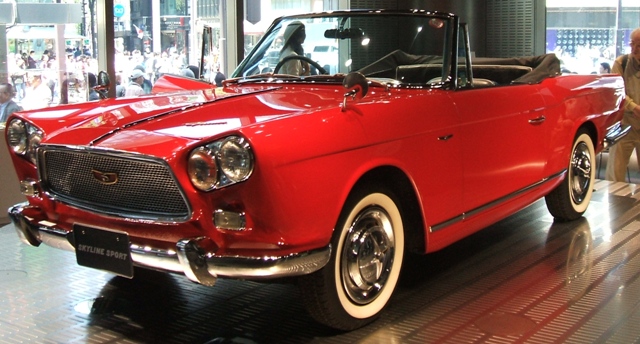The iconic bruiser from Japan has gone down in performance car folklore, as popular in video games and on the big screen as with its legion of devoted fans.
Originally a luxury saloon manufactured by the Prince Motor Company in 1957, the car evolved into the legendary Nissan Skyline GT-R, a tuner’s favourite dubbed “Godzilla, the monster from Japan” by the Australian press.
We look back at 60 years of motoring’s Beast from the East.
No car from Japan has inspired the kind of awe and fanaticism that surrounds the Nissan Skyline GT-R.
Its earth-shattering performance has made it a fixture in popular culture for more than 20 years thanks to appearances in the Gran Turismo and Need for Speed video games, and the Fast and Furious movies.
But it wasn’t always Japan’s pre-eminent road-shredder and drift king, emerging from the post-war era as a luxury saloon with American-influenced styling and manufactured by the Prince Motor Company in the Suginami district of Tokyo.
Prince, named in honour of the current Emperor of Japan, Prince Akihito, was the rebranded Fuji Precision Industries, itself formed out of the dissolved Tachikawa Aircraft company, which made planes for the Imperial Japanese Army Air Force.
The first Skyline was introduced in April, 1957, all tail-fins, chrome and two-tone paint, powered by the 1.5-litre, 60hp unit already seen in the Subaru 1500 – the company’s first road car.
So far, so ordinary, but the first inkling of what was to come was 1961’s Skyline Sport, handsomely-styled by Michelotti and hand-built in coupe and convertible form.
Featuring Triumph Vitesse-style slanted, twin headlamps and a 1.9-litre OHV unit, only a few hundred were built, but the car began its long movie career in the Toho films of the 1960s, taking a battering from the street-stomping Godzilla.
Skyline hits the track and a legend is born
The blue touchpaper was well and truly lit in 1964, when Prince decided to go racing with the new Skyline GT, fitted with a souped-up straight six, triple-carb engine that would only fit the engine bay thanks to a longer nose.
Having only just met the 100 production units required to race in the GT-II class at the Suzuka Grand Prix meeting, the brainchild of chief engineer Shinichiro Sakurai was about to do the unthinkable and lay down a serious challenge to the mighty Porsche 904 Carrera GTS.
Although beaten to the chequered flag by the 160mph Porsche, the Skyline of Tetsu Ikuzawa stunned the crowd, and all of Japan, by overtaking and holding off the German car for a lap.
Skylines drifted their way round Suzuka and claimed the next five places behind the Porsche.
The GT went into full production, and this was the car that convinced engineers at the company that would become Nissan two years later to keep tweaking and refining their future sporting champion.
Nissan takes charge and the GT-R is born
Just as Prince’s new performance star was setting out on its path to greatness, the Japanese government was hatching a plan to concentrate the country’s motor industry into fewer, larger manufacturers to reduce internal competition and aid success overseas.
Thus, having laid the groundwork for the car’s success, Prince was amalgamated into Nissan-Datsun in 1966, ensuring its future as a sporting icon.
It took a few years for the first car to bear the GT-R badge to arrive, however, with an eager public first introduced to the Skyline 2000GT-R at the 1969 Tokyo Auto Show.
Available only in saloon form until a coupe was introduced in 1971, power came from a DOHC 2-litre engine developed by Prince engineers and almost identical to the unit deployed in the R380 race-car.
The in-line six produced 160bhp at 7,000rpm and 130lb-ft of torque at 5,600rpm, helping to propel the GT-R to a total of 83 touring car race wins.
Primarily targeted at racing, production of road cars was limited to 1,945, with only a few hundred of the so-called Hakosuka GT-Rs (“hako” meaning boxy, and “suka” from the Japanese pronunciation of Skyline) now surviving.
Consequently, prices have skyrocketed, with unmodified examples fetching more than £100,000, despite the car looking a little like an angry Triumph Acclaim.
But for that you get the grandaddy of the GT-Rs, a free-revving, fine-handling predecessor to the fire-breathers to come.
Oil crisis and the end of the GT-R?
The Kenmeri Skyline – so-called because of the Japanese advert featuring young couple Ken and Mary enjoying their car in the countryside – moved away from its predecessor’s boxy styling when it was introduced in 1972.
The GT-R version only lasted six months in production, however, as the oil crisis bit hard into customer demand for performance cars.
Nissan pulled the plug on all motor racing; no motor racing, no point to the GT-R, and the Skyline went through 16 years and skipped three redesigns before the three letters were to reappear on the R32.
Not that Nissan entirely ditched the idea of performance versions in the interim: there was the turbocharged GT-EX boasting 145hp, then in 1983 the 188hp 2000RS-Turbo, upgraded to 205hp the following year in the RS-X Turbo C.
It was this car, now a cult classic in its homeland and still regularly drag-raced, that paved the way for the return of the GT-R in 1989, via the 210bhp R31 GTS-R of 1987.
Like our illustration of the Nissan Skyline at the beginning of the article?
Download a free high-quality poster version here.
Rebirth and a second coming for a modern legend
The first GT-R for 16 years, and the birth of the modern legend, was the R32 introduced in 1989 – dubbed at the time by Car magazine as “the world’s most advanced road car”.
Engineered by Nissan’s Nismo sports division, it featured the 2.6-litre RB26DETT I6, twin turbo, six-cylinder engine officially producing 280bhp to keep below Japanese manufacturers’ “gentlemen’s agreement” of a maximum of 300bhp, but unofficially thought to pump out 320bhp.
The first all-wheel-drive GT-R, unlike previous models the plan had been to race all along, with the racing spec cars designed to produce 500bhp and aimed squarely at toppling the Porsche 959.
So successful was the Skyline, in NISMO form, winning 29 races from 29 starts in the Japanese Touring Car Championship (JTCC) from 1989 to 1993, and ending the Ford Sierra Cosworth’s dominance in Australia, it effectively hastened the end of Group A touring car racing and fractured the JTCC.
The Skyline had out-Porsched Porsche, and everyone else too.
Key to the GT-R’s stunning handling was the revolutionary Electronic Torque Split 4wd system, which varied torque delivery to the front wheels, multi-link suspension, and advanced all-wheel steering that gave the car additional stability while cornering.
Testing the car at the Nurburgring, as tough as any test gets, Car magazine was in no doubt about the GT-R’s brilliance.
“The engine pulls comfortably from low revs, growing increasingly truculent as the revs build. The deep engine note turns into a growl, and then into a bellow. The turbos come in quite smoothly, but when they’re engaged, the GT-R surges forward: even in a straight line, it feels like a pukka supercar. To boot, the big six is smooth, refined.
“The GT-R flatters your driving, making ham-fisted drivers smoother, and giving extra traction and security where a normal car would bite.
“Although not the most inspiring, accelerative, or beautiful of cars, the Skyline is now surely the world’s most awesomely competent road machine.”
Bigger, better, faster: the R33 is born
One inch wider and four inches longer than its predecessor, the R33 GT-R broke the mould in performance cars that also doubled as a civilised, everyday drive.
Hitting 60mph in just five seconds, quicker than a normally aspirated Porsche 911 (993), and again honed at the Nurburgring, where Dirk Schoysman completed a lap in under eight minutes – the first mainstream production car to do so.
A limited edition NISMO version, producing 400bhp, was produced to celebrate the car’s participation at Le Mans, where it finished a remarkable 10th up against supercars of the time like the McLaren F1 GTR.
The 400R of 1997 was faster still, its upgraded camshafts, oil system, exhaust manifolds and turbochargers helping propel just 44 cars made from 0-60mph in just four seconds flat.
Tuners took to the R33 in their droves, with top tuning companies producing kits for road and track use – an HKS GT-R held a drag record for several years and became the world’s fastest all-wheel-drive car.
Legend status assured by Fast and Furious R34
Already legendary in its homeland and limited export markets, the Skyline R34 GT-R cemented its global reputation and gained an army of new fans thanks to its appearance in The Fast and The Furious movie of 2001.
Unfortunately for American fans of Paul Walker et al, the GT-R was banned in the US because of emissions regulations.
The car was as revolutionary as ever, the culmination of more than a decade of race-honed development, ever more sharp and aggressive styling and technologically way ahead of its time.
Officially still producing under 300bhp, by the time tuners had got their hands on the ceramic twin-turbo inline six, it was capable of pumping out a barely credible 800bhp.
A multi-function LCD screen displayed seven different live vehicle statistics, including turbo boost pressure, oil and water temperature – with a Nismo extra providing a lap-timer and G-Force meter, unheard of on a road car at the time.
By far the biggest-seller was the V-Spec (Victory Specification), with just 80 finding their way to the UK before the introduction in 2000 of the V-Spec II.
The V-Spec could outsprint both the Porsche 911 Carrera 4 and the BMW M5, as testers at Car magazine South Africa discovered in 2000.
It wasn’t just the blistering performance, by now taken for granted, that marked the GT-R out as an astonishing vehicle.
“The Skyline is easier to use in everyday traffic than most supercars thanks to its typically light Japanese-style controls. The clutch is easy enough for your grandma, the gearchange meaty and slick.
“Steering is precise, and low-speed throttle response is smooth and seamless.”
But while that’s a bonus, the GT-R wasn’t made for school runs and shopping trips.
“The Skyline really comes alive when the tach reaches the 4,000 mark, boring forward with supercar power as you bury your right foot. It’s an addictive feeling, so one is constantly tempted to use the towering performance.
“Road-holding is cat-like, the electronic four-wheel-drive system and rear-wheel steering rocketing the car through corners as if on rails. Unless, of course, you decide to fling the car sideways into the bends…
“So impressive is this car’s engineering that even the dyed-in-the-wool BMW and Porsche fans on our test team had to agree: the Skyline GTR has both the dynamics and build integrity to better the comparable offerings from Munich and Zuffenhausen.”
Tuners were still having a field day with the car, none more so than Nismo themselves with the outrageous Z-Tune, a series of rebuilt used V-Specs using an engine based on the Le Mans GT2 and GT500 racing units.
After an initial one-off, Nissan gave permission to buy a further 18 used V-Specs and hand-build a series of Z-Tunes for Nismo’s anniversary.
The 2.8-litre engine, suspension and brake systems were modified to produce a car capable of hitting 60mph in 3.8 seconds on its way to 203mph.
The end of the road
The R34 was the last car to bear the Skyline GT-R name, the two brands separating and living on in distinct models.
The Skyline left the out-and-out sporting scene for the V35 model, while the GT-R became its own distinct sports car launched at the Tokyo Motor Show in 2007.
It has since gone on to cement its own modern legend in performance motoring, with typically advanced engineering and stunning performance that’s still leaving more glamorous, prestige marques like Porsche and BMW gasping.
So as the Skyline name celebrates its 60th birthday in 2017, it’s gone back to its luxury saloon roots, but not without leaving an unmatched legacy of barnstorming performance and technological brilliance.
















